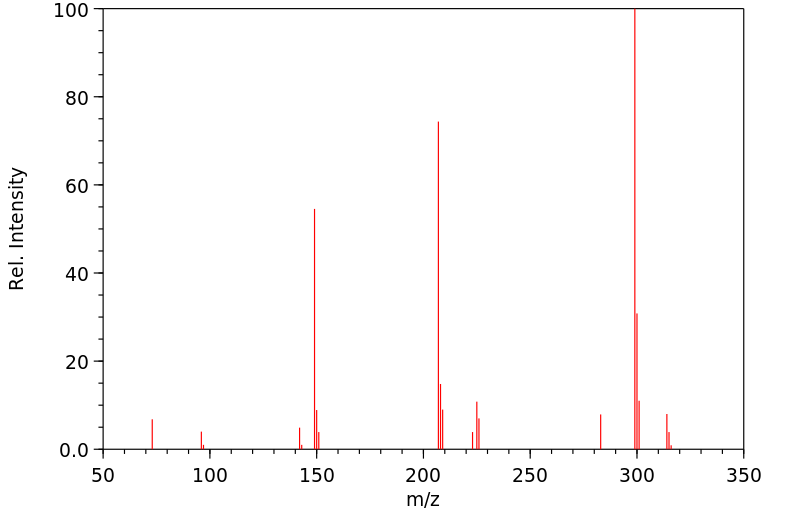1,3-二(对甲苯基)-1,1,3,3-四甲基二硅氧烷 | 18055-70-4
中文名称
1,3-二(对甲苯基)-1,1,3,3-四甲基二硅氧烷
中文别名
——
英文名称
1,1,3,3-tetramethyl-1,3-di-p-tolyldisiloxane
英文别名
1,1,3,3-tetramethyl-1,3-bis(p-tolyl)disiloxane;1,3-DI(P-Tolyl)-1,1,3,3-tetramethyldisiloxane;[dimethyl-(4-methylphenyl)silyl]oxy-dimethyl-(4-methylphenyl)silane
CAS
18055-70-4
化学式
C18H26OSi2
mdl
——
分子量
314.575
InChiKey
MEQYEVSZYLVDNX-UHFFFAOYSA-N
BEILSTEIN
——
EINECS
——
-
物化性质
-
计算性质
-
ADMET
-
安全信息
-
SDS
-
制备方法与用途
-
上下游信息
-
文献信息
-
表征谱图
-
同类化合物
-
相关功能分类
-
相关结构分类
物化性质
-
沸点:143-144 °C(Press: 1 Torr)
-
密度:0.9651 g/cm3(Temp: 25 °C)
计算性质
-
辛醇/水分配系数(LogP):3.84
-
重原子数:21
-
可旋转键数:4
-
环数:2.0
-
sp3杂化的碳原子比例:0.33
-
拓扑面积:9.2
-
氢给体数:0
-
氢受体数:1
安全信息
-
海关编码:2934999090
SDS
上下游信息
反应信息
-
作为反应物:描述:1,3-二(对甲苯基)-1,1,3,3-四甲基二硅氧烷 在 N-羟基丁二酰亚胺 、 氧气 、 cobalt(II) diacetate tetrahydrate 、 碳酸氢钠 作用下, 以 乙腈 、 乙醇 、 水 为溶剂, 50.0~60.0 ℃ 、101.33 kPa 条件下, 反应 26.0h, 以90%的产率得到4,4'-(1,1,3,3-tetramethyldisiloxane-1,3-diyl)dibenzoic acid参考文献:名称:需氧 Co-/N-羟基琥珀酰亚胺催化对甲苯基硅氧烷氧化为对羧基苯基硅氧烷:合成功能化硅氧烷作为硅氧烷基材料的有希望的构建块摘要:合成在有机取代基中具有“极性”官能团的有机硅产品是当今有机硅化学中最基本和最重要的挑战之一。在我们的研究中,我们提出了解决这个问题的方法,即基于需氧 Co-/N-羟基琥珀酰亚胺 (NHSI) 催化对甲苯基硅氧烷氧化成对羧基苯基硅氧烷的高效制备方法。该方法基于“绿色”、市售、简单且廉价的试剂,并采用温和的反应条件:Co(OAc)2/NHSI 催化体系,O2 作为氧化剂,工艺温度为 40 至 60 °C,大气压。该反应是通用的,可以合成对羧基苯基在 1,1-、1,3-、1,5- 和 1 处的单-和二-、三-和聚(对-羧基苯基)硅氧烷, 1、1-职位。所有产物均以克量(高达 5 g)和高产率(80-96%)获得并分离,并通过 NMR、ESI-HRMS、GPC、IR 和 X 射线数据表征:结晶中的对羧基苯基硅氧烷状态形成类似 HOF 的结构。此外,表明该方法适用于将有机烷基芳烃衍生物(Ar-CH3DOI:10.1021/jacs.8b12600
-
作为产物:描述:参考文献:名称:The Oxidation of Tetramethyl-1,3-bis-(p-tolyl)-disiloxane to 1,3-Bis-(p-carboxyphenyl)-tetramethyldisiloxane摘要:DOI:10.1021/ja01131a511
文献信息
-
Disiloxane Synthesis Based on Silicon–Hydrogen Bond Activation using Gold and Platinum on Carbon in Water or Heavy Water作者:Yoshinari Sawama、Masahiro Masuda、Naoki Yasukawa、Ryosuke Nakatani、Shumma Nishimura、Kyoshiro Shibata、Tsuyoshi Yamada、Yasunari Monguchi、Hiroyasu Suzuka、Yukio Takagi、Hironao SajikiDOI:10.1021/acs.joc.6b00556日期:2016.5.20that disiloxanes were effectively constructed of hydrosilanes catalyzed by gold on carbon in water as the solvent and oxidant in association with the emission of hydrogen gas at room temperature. The present oxidation could proceed via various reaction pathways, such as the hydration of hydrosilane into silanol, dehydrogenative coupling of hydrosilane into disilane, and the subsequent corresponding
-
Nickel(0) catalyzed oxidation of organosilanes to disiloxanes by air as an oxidant作者:Haiping Lv、Ronibala Devi Laishram、Jiayan Li、Guangrui Shi、Weiqing Sun、Jianbin Xu、Yong Yang、Yang Luo、Baomin FanDOI:10.1016/j.tetlet.2019.03.002日期:2019.4We report here an efficient non-aqueous route to symmetrical disiloxanes from their corresponding organosilanes using Ni(COD)2 with 3,4,7,8-tetramethyl-1,10-phenanthroline in air. Our methodology is very simple and high yielding. The reaction mechanism is also proposed.
-
Preparation of the iodides (Me3Si)2C(SiMe2C6H4Y)(SiMe2I) and some related compounds作者:Colin Eaborn、Karen L. Jones、Paul D. LickissDOI:10.1016/0022-328x(94)88026-3日期:1994.2The preparations of: (a) the iodides (Me3Si)2C(SiMe2C6H4Y)(SiMe2I) (Y = H,p- OMe,p-Me,p-Cl,m-CF3),via the corresponding hydrides; (b) the compounds (Me3Si)2C(SiMe2Ph)(SiMe2X) with X = F, O2CCF3, O2CCH3, OMe, N3, NCS and Cl; and (c) the iodide (p-MeC6H4)3CSiMe2I are described.
-
Aryl-Aryl Bond Formation by the Fluoride-Free Cross-Coupling of Aryldisiloxanes with Aryl Bromides作者:Christine M. Boehner、Elizabeth C. Frye、Kieron M. G. O'Connell、Warren R. J. D. Galloway、Hannah F. Sore、Patricia Garcia Dominguez、David Norton、David G. Hulcoop、Martin Owen、Gillian Turner、Claire Crawford、Helen Horsley、David R. SpringDOI:10.1002/chem.201102285日期:2011.11.18synthetically important molecules has inspired considerable interest in the development of methods for aryl–aryl bond formation. Herein we describe a novel strategy for this process involving the fluoride‐free, palladium‐catalysed cross‐coupling of readily accessible aryldisiloxanes and aryl bromides. Using a statistical‐based optimisation process, preparatively useful reaction conditions were formulated
-
Zur synthese von siloxanen
表征谱图
-
氢谱1HNMR
-
质谱MS
-
碳谱13CNMR
-
红外IR
-
拉曼Raman
-
峰位数据
-
峰位匹配
-
表征信息
同类化合物
(βS)-β-氨基-4-(4-羟基苯氧基)-3,5-二碘苯甲丙醇
(S,S)-邻甲苯基-DIPAMP
(S)-(-)-7'-〔4(S)-(苄基)恶唑-2-基]-7-二(3,5-二-叔丁基苯基)膦基-2,2',3,3'-四氢-1,1-螺二氢茚
(S)-盐酸沙丁胺醇
(S)-3-(叔丁基)-4-(2,6-二甲氧基苯基)-2,3-二氢苯并[d][1,3]氧磷杂环戊二烯
(S)-2,2'-双[双(3,5-三氟甲基苯基)膦基]-4,4',6,6'-四甲氧基联苯
(S)-1-[3,5-双(三氟甲基)苯基]-3-[1-(二甲基氨基)-3-甲基丁烷-2-基]硫脲
(R)富马酸托特罗定
(R)-(-)-盐酸尼古地平
(R)-(-)-4,12-双(二苯基膦基)[2.2]对环芳烷(1,5环辛二烯)铑(I)四氟硼酸盐
(R)-(+)-7-双(3,5-二叔丁基苯基)膦基7''-[((6-甲基吡啶-2-基甲基)氨基]-2,2'',3,3''-四氢-1,1''-螺双茚满
(R)-(+)-7-双(3,5-二叔丁基苯基)膦基7''-[(4-叔丁基吡啶-2-基甲基)氨基]-2,2'',3,3''-四氢-1,1''-螺双茚满
(R)-(+)-7-双(3,5-二叔丁基苯基)膦基7''-[(3-甲基吡啶-2-基甲基)氨基]-2,2'',3,3''-四氢-1,1''-螺双茚满
(R)-(+)-4,7-双(3,5-二-叔丁基苯基)膦基-7“-[(吡啶-2-基甲基)氨基]-2,2”,3,3'-四氢1,1'-螺二茚满
(R)-3-(叔丁基)-4-(2,6-二苯氧基苯基)-2,3-二氢苯并[d][1,3]氧杂磷杂环戊烯
(R)-2-[((二苯基膦基)甲基]吡咯烷
(R)-1-[3,5-双(三氟甲基)苯基]-3-[1-(二甲基氨基)-3-甲基丁烷-2-基]硫脲
(N-(4-甲氧基苯基)-N-甲基-3-(1-哌啶基)丙-2-烯酰胺)
(5-溴-2-羟基苯基)-4-氯苯甲酮
(5-溴-2-氯苯基)(4-羟基苯基)甲酮
(5-氧代-3-苯基-2,5-二氢-1,2,3,4-oxatriazol-3-鎓)
(4S,5R)-4-甲基-5-苯基-1,2,3-氧代噻唑烷-2,2-二氧化物-3-羧酸叔丁酯
(4S,4''S)-2,2''-亚环戊基双[4,5-二氢-4-(苯甲基)恶唑]
(4-溴苯基)-[2-氟-4-[6-[甲基(丙-2-烯基)氨基]己氧基]苯基]甲酮
(4-丁氧基苯甲基)三苯基溴化磷
(3aR,8aR)-(-)-4,4,8,8-四(3,5-二甲基苯基)四氢-2,2-二甲基-6-苯基-1,3-二氧戊环[4,5-e]二恶唑磷
(3aR,6aS)-5-氧代六氢环戊基[c]吡咯-2(1H)-羧酸酯
(2Z)-3-[[(4-氯苯基)氨基]-2-氰基丙烯酸乙酯
(2S,3S,5S)-5-(叔丁氧基甲酰氨基)-2-(N-5-噻唑基-甲氧羰基)氨基-1,6-二苯基-3-羟基己烷
(2S,2''S,3S,3''S)-3,3''-二叔丁基-4,4''-双(2,6-二甲氧基苯基)-2,2'',3,3''-四氢-2,2''-联苯并[d][1,3]氧杂磷杂戊环
(2S)-(-)-2-{[[[[3,5-双(氟代甲基)苯基]氨基]硫代甲基]氨基}-N-(二苯基甲基)-N,3,3-三甲基丁酰胺
(2S)-2-[[[[[((1S,2S)-2-氨基环己基]氨基]硫代甲基]氨基]-N-(二苯甲基)-N,3,3-三甲基丁酰胺
(2S)-2-[[[[[[((1R,2R)-2-氨基环己基]氨基]硫代甲基]氨基]-N-(二苯甲基)-N,3,3-三甲基丁酰胺
(2-硝基苯基)磷酸三酰胺
(2,6-二氯苯基)乙酰氯
(2,3-二甲氧基-5-甲基苯基)硼酸
(1S,2S,3S,5S)-5-叠氮基-3-(苯基甲氧基)-2-[(苯基甲氧基)甲基]环戊醇
(1S,2S,3R,5R)-2-(苄氧基)甲基-6-氧杂双环[3.1.0]己-3-醇
(1-(4-氟苯基)环丙基)甲胺盐酸盐
(1-(3-溴苯基)环丁基)甲胺盐酸盐
(1-(2-氯苯基)环丁基)甲胺盐酸盐
(1-(2-氟苯基)环丙基)甲胺盐酸盐
(1-(2,6-二氟苯基)环丙基)甲胺盐酸盐
(-)-去甲基西布曲明
龙蒿油
龙胆酸钠
龙胆酸叔丁酯
龙胆酸
龙胆紫-d6
龙胆紫








